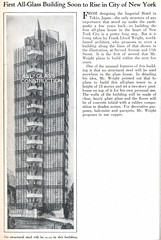An eclectic group of musicians – including Gordon Gano belting out his Violent Femmes classic “Blister in the Sun” – performed last night at a benefit to “put a stop to this destructive, environmentally calamitous process that’s destroying the city we all love.” At least, that’s how the evening’s M.C., Mark Crispin Miller of Faculty Against the Sexton Plan, put it shortly before announcing that Susan Sarandon and Matthew Broderick were among those who pledged money to a lawsuit against N.Y.U.’s expansion plans.
The idea behind the “Save the Village” concert at Le Poisson Rouge, Mr. Miller told an audience of about 200, was to show that the Village still rocks – even if “N.Y.U. does not rock. N.Y.U. rolls. It rolls its students; it rolls its faculty; it rolled the City Council. We’ve got to stop this.”
To that end, songstress Janine Nichols kicked off the night by cooing “This Land Is Your Land” with John Kruth on sitar. (It was that kind of evening: bongos, banjos, cowbells, canastas, and, yes, even scatting. At times the Greenwich Village club resembled a genuine Beat coffee shop.)
Noise rocker Thurston Moore of Sonic Youth got right into it with composer and saxophonist John Zorn. The duo launched into a cacophany of discordant free jazz that had all the abrasiveness of, well, jackhammering south of Washington Square Park. Read more…
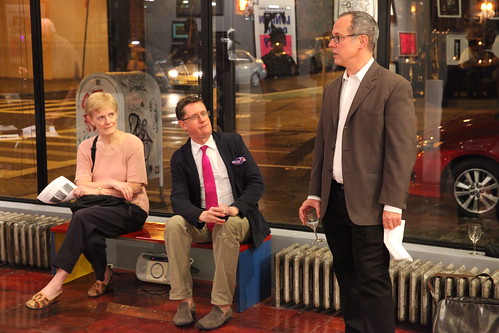 Richard Moses (right) at LESPI’s birthday bash.
Richard Moses (right) at LESPI’s birthday bash.At a meeting on Tuesday, the Landmarks Preservation Commission may well create a new East Village/Lower East Side Historic District encompassing over 300 buildings. But the Lower East Side Preservation Initiative isn’t waiting till then to celebrate: the group marked its fifth anniversary last night with bubbly and birthday cake at Smart Clothes Gallery on Stanton Street. Since preservation architects Richard Moses and Britton Baine – inspired by a screening of “Slumming It: Myth and Culture on the Bowery” – started the organization in 2007, they’ve gone on to become instrumental in the creation of a 10th Street Historic District and have led countless tours and discussions about neighborhood history and architecture. The Local chatted with Mr. Moses as he prepared for last night’s birthday bash.
Q.
You’ve garnered opposition from religious groups in the community in regards to landmarking. Have others opposed your projects and how do you handle the situation?
A.
There were a few property owners who were opposed. They came out and expressed their opposition, but there wasn’t a huge number of them by any means; I would say a few.
It’s a tricky situation because emotions tend to run high on both sides. Certainly we’re sympathetic to concerns of religious institutions on the idea that they want their congregation to be thriving and we certainly want them to be thriving – we don’t want them to burdened. We feel sometimes that there’s a misunderstanding of some of the requirements of the Landmarks Commission and that there’s a different focus on short-term versus long-term goals. Read more…
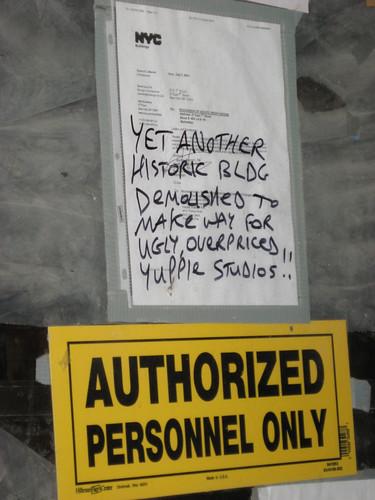 Sarah Darville A note from a militant preservationist?
Sarah Darville A note from a militant preservationist?Workers renovating the closed — and illegal — hostel at 27 East Seventh Street today didn’t seem too interested in a note scribbled over work permits on the building. “Yet another historic bldg demolished to make way for ugly, overpriced yuppie studios!!” the note read. Read more…
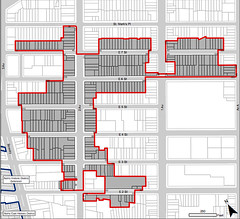 Map of the proposed district.
Map of the proposed district.Preservationists came out in force today to support a proposed historic district that would encompass a large chunk of the East Village, and ran into familiar anger from religious groups.
The Landmarks Preservation Commission held the public hearing to collect feedback on a proposed 330-building district that would be centered around Second Avenue south of St. Marks Place and regulate the facades of cultural icons like the La MaMa theater, the former Fillmore East building, and the Anthology Film Archives, among other storied buildings.
At the meeting, which was standing-room only for the first hour and a half, members of the commission listened to about 80 speakers express more support than opposition, with many sporting blue and yellow stickers reading “Preserve the East Village, Landmark Now!” Read more…
Yesterday the executive director of the Greenwich Village Society for Historic Preservation, Andrew Berman, shared the history of six buildings that may soon be part of the proposed East Village-Lower East Side Historic District. Before this afternoon’s critical hearing, he’s delving into the history of six others.
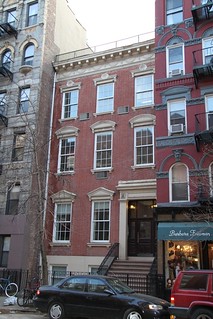 G.V.S.H.P. 68 East Seventh Street
G.V.S.H.P. 68 East Seventh Street68 East Seventh Street, built in 1835. This row house at 68 East Seventh Street was built speculatively in 1835 by Thomas E. Davis. Sometime in the 1850s or 1860s, the original Greek Revival façade was updated with Italianate details that include the triangular and segmental window pediments and the frieze located below the original cornice. In 1882, the house was sold to the Protestant Episcopal Church Society for Promoting Christianity Among the Jews, which occupied it until 1904, when the house became a Jewish religious school operated by the Machzikei Talmud Torah. It was then subsequently a synagogue. The house was returned to private residential use in 1960. Read more…
After a failed demolition attempt by would-be developers, the historic building at 128 East 13th Street will hit the auction block thanks to an order from a State Supreme Court judge, The Real Deal reports. The building, which was home to one of the city’s leading sellers of horses and horse-drawn carriages and later served as sculptor Frank Stella’s studio, was the subject of much lobbying by preservationists once developers Isaac Mishan and Joseph Sabbah revealed plans to replace it with a seven-story building in 2006. The pair defaulted on $10.5 million in loans, resulting in last week’s court order.
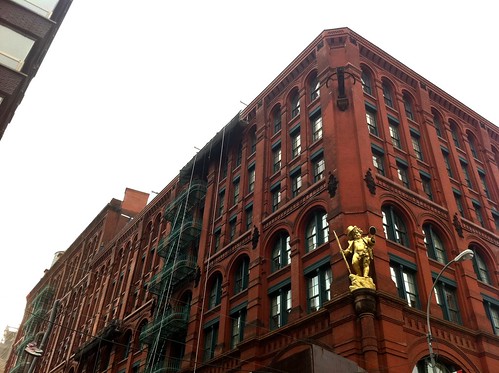 Ian Duncan The Puck Building with its gold mascot
Ian Duncan The Puck Building with its gold mascotPuck, the mascot of the building of the same name on the corner of Houston Street and Mulberry Street, is facing the prospect of some shiny glass condos above his shiny gold top hat. Kushner Companies, the building’s owner, wanted to stick apartments on the roof of the landmarked structure. The Landmarks Preservation Commission told it no back in September. Today, it again said no to revised, more modest designs.
In an e-mail, a spokeswoman for the commission said, “The Commissioners did not approve the proposal as presented. They commented and voiced a variety of concerns about the bulk, scale and design of the proposal.” Read more…
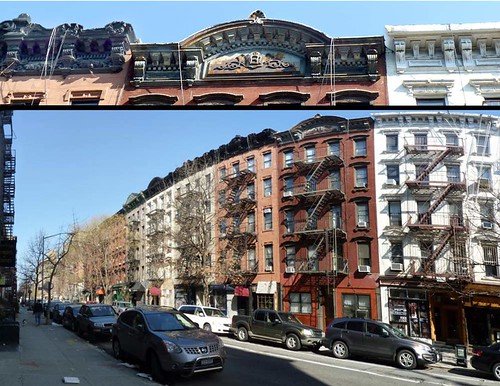 Michael Natale East 10th Street
Michael Natale East 10th StreetToday on The Local, we’re hosting a dialogue about the neighborhood’s proposed historic districts. First, below, Britton Baine and Richard Moses, who serve on the steering committee of the Lower East Side Preservation Initiative, speak out in favor of them. Later, architect Ido Nissani argues that one of the districts would burden and disrespect the synagogue he attends. Add your own thoughts via the comments.
This has been an exciting time for the East Village and its historic architecture. In June, the city Landmarks Preservation Commission calendared for public hearing two new historic districts: the proposed East Village-Lower East Side and East 10th Street districts. In July, after three contentious public hearings, Community Board 3 voted with a strong majority to support landmarking these districts.
The question now is, when will the LPC schedule the hearing date for their designation? For preservationists, sooner is much better than later, because until the LPC votes to landmark the districts, the buildings will not be completely safe from defacement or demolition.
Two questions preservationists have been hearing are, why landmark, and how will landmarking benefit the East Village? There are many reasons. Read more…
Community Board 3 tonight approved the creation of two historic districts in the East Village, paving the way for official consideration by the city. The proposal was divided into two separate motions with a 23 to 9 vote in favor of the Second Avenue district and unanimous support for the Tenth Street district. Preservationists reiterated that the measures were the only way to protect the neighborhood from what they consider excessive development while opponents from the religious community, some of whom walked out of the meeting in protest, countered that they could not bear the financial burden of renovations under the landmarking requirements.
—Laura E. Lee and Stephen Rex Brown
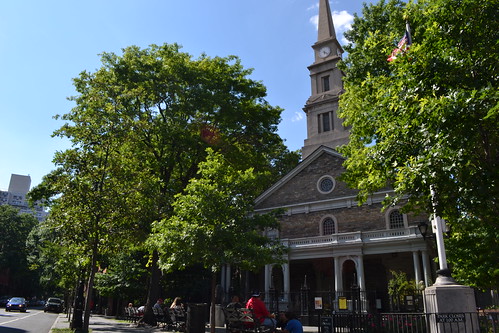 Ian Duncan St. Mark’s in the Bowery as it looks today, and below, a rendering of one of the towers that might have stood on the site, courtesy of Modern Mechanix.
Ian Duncan St. Mark’s in the Bowery as it looks today, and below, a rendering of one of the towers that might have stood on the site, courtesy of Modern Mechanix.Frank Lloyd Wright is probably not a name to make the hearts of preservationists quake. But if the architect had had his way, tonight’s debate on a new East Village historic district would have been held in a very different context.
In the late 1920’s, Wright proposed tearing down the row houses on East 10th and Stuyvesant Streets and building over the cemetery at St. Mark’s in the Bowery to make way for four glass skyscrapers. Plans held by the Museum of Modern Art show the church crowded in by the towers: at 19 stories they would have rivaled the Cooper Square Hotel for size.
And just as two East Village clerics have come out as opponents of the preservation area, it was The Reverend William Norman Guthrie, the rector of St. Mark’s, egging Wright on.
The church’s once-affluent congregation had been whittled away as the Lower East Side became a home to immigrants. Guthrie approached Wright in 1927, commissioning him to design an apartment tower on church land, hoping the rent would restore its ailing finances.
“At that time, Wright’s career was in the doldrums,” said Hilary Ballon, an expert on his work and deputy vice chancellor of NYU Abu Dhabi. “Getting to build a skyscraper in New York was a great restart.”
Read more…










